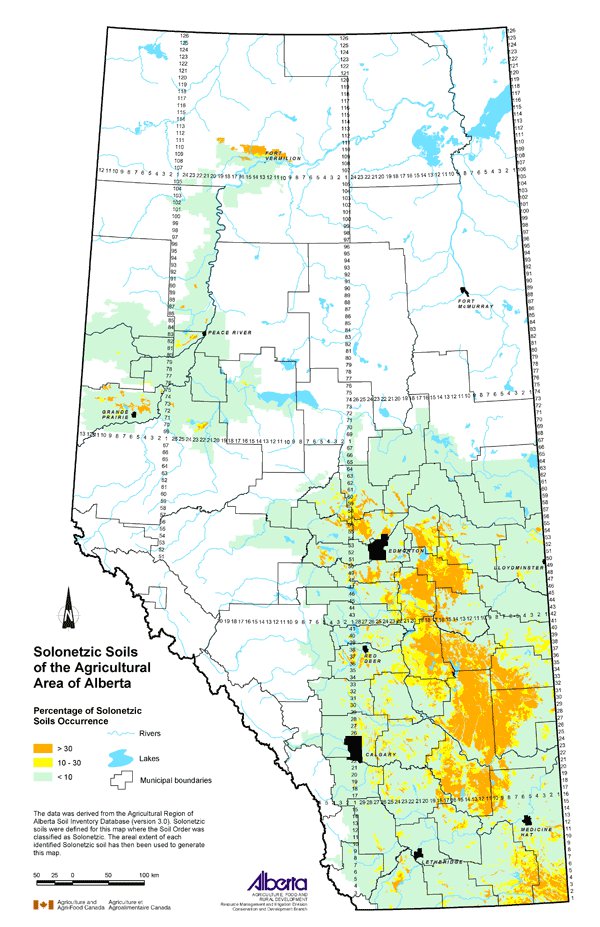| | Description | Data sources | Potential uses | Limitations | Further information | Download spatial information
Description
This map displays the distribution of Solonetzic soils in the agricultural region of Alberta. Solonetzic soils have developed on saline parent material that is high in sodium and have a characteristic hardpan layer that has formed in the subsoil. This hardpan is very hard when dry and has low permeability when wet. This results in restricted root and water penetration that may limit the productivity of these soils. Solonetzic soils occur in association with Chernozemic soils and, to a lesser extent, with Luvisolic soils.
The Agricultural Region of Alberta Soil Inventory Database (AGRASID) soil landscape polygons that contained soils belonging to the Solonetzic Order were identified, and the areal extent of these soils was represented as a percentage of the total area using the following classes: greater than 30, 10 to 30 and less than 10.
Data Sources
The data for this map was derived from AGRASID 3.0. AGRASID is a digital database describing the spatial distribution of soils and associated landscapes within the agricultural region of Alberta.
Potential Uses
Recognizing where areas of Solonetzic soils are found in the province is important for producers due to the management requirements of these soils. If the presence of Solonetzic soils appears to be limiting a soil's productivity, further investigation may be required. Through a number of agronomic field trials, Solonetzic soil properties with the greatest potential for improvement have been identified and crop responses determined. Management techniques that improve the productivity of these soils have been developed. Recognizing the low organic matter content and increased erosion potential of these soils is important when completing an environmental farm plan.
Limitations
The map shows the areal extent of soils in the Solonetzic Order. The nature of these soils makes them quite variable with respect to factors such as depth of topsoil, fertility and subsoil characteristics. This variability often requires further investigation to verify the distribution and degree of severity of Solonetzic soils within a soil landscape polygon.
Further Information
Alberta Agriculture and Food (AF) provides additional information about managing Solonetzic Soils. From the AF website, under Quick Links on the right side, follow: Publications & More, then Soils and Water Publications. www.agric.gov.ab.ca/publications
AGRASID provides extensive soil information and is available to download from the Alberta Soil Information Centre at the AF website. www.agric.gov.ab.ca/asic
Canadian Soil Information System (CanSIS) provides information about Solonetzic soils. Manuals including The Canadian System of Soil Classification are available from the website. http://sis.agr.gc.ca/cansis
Click on map for larger view

Download Spatial Information
Agricultural Land Resource Atlas of Alberta - Solonetzic Soils of the Agricultural Area of Alberta
|
|